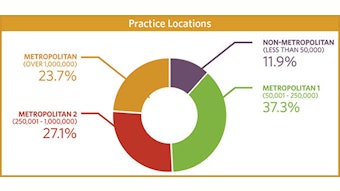9 ideas for marketing on a small budget
Marketing in 2018 extends far beyond bygone days of mailers and radio ads. While these are still important to your overall strategy, there are a slew of cost-effective (and sometimes free) ways to increase your presence in your community. Content reigns in marketing today, so ensure that your message not only reflects your practice’s mission but provides educational information for the consumer.
FROM THE ASSOCIATION OF OTOLARYNGOLOGY ADMINISTRATORS
Editor’s Note: Welcome the AOA and this new quarterly feature
Marketing in 2018 extends far beyond bygone days of mailers and radio ads. While these are still important to your overall strategy, there are a slew of cost-effective (and sometimes free) ways to increase your presence in your community. Content reigns in marketing today, so ensure that your message not only reflects your practice’s mission but provides educational information for the consumer.
While a lot of practices might not think to budget for marketing efforts, it is vital to the health of your practice to get the word out to prospective patients. Here are some lower-cost and no-cost options that you can institute and utilize to increase your number of patients.
1. Your website content needs to be current—and mobile friendly. If you haven’t updated your website in the past few years, you need to make that happen now. Create a page about each physician in your practice, including a brief biography (include fun facts—favorite sport, hobbies, etc.) and a professional headshot in a white coat or business attire. Adding new content periodically also helps improve your Google rankings. And if you haven’t touched your site design in a while, you can always find a price point to fit your budget.
2. Invest in search engine optimization (SEO). Spending a little can go a long way when it comes to SEO. Make sure your website is using the same phrases that patients, caretakers, family members, and others are using to look for your services. Chances are, most people who search for hearing aid services aren’t going to type “otolaryngology.” Consult with a company that can optimize your search rankings.
3. Have a social media presence. Appoint one of your staff to develop posts and monitor the channels. Create posts about diseases, staff, physician accomplishments, patient care, etc. But don’t try to launch into every network at once; start with one network—such as Facebook—and increase your presence before launching new ones. Facebook continues to grow, with one-in-five internet page views in the United States being on Facebook.
4. Utilize available educational posters each month in your patient exam room, waiting room, and office. Put them on the backof the door so the patient can see them while they wait. The AAO-HNS has many health observation campaigns that allow you to download various materials and posters on a variety of relevant topics. For example, download information for Better Speech and Hearing Month that you can offer in your waiting area at: www.entnet.org/content/block-out-noise.
5. Visit your top referring physicians. Send your office manager to meet with your top referring physicians at least quarterly. Equip them with a supply of giveaways and business cards to replenish. They could take coffee and donuts for the staff and continue to educate and reinforce what patient services you offer in the practice.
6. Keep your presence known around town. Have you introduced yourself to your closest hospital and OR? Make facetime! When you hear that a new physician has come to town, pick up the phone, welcome them to your community, and tell them about your services.
7. Send out a timely newsletter with healthy tips. Determine a realistic distribution timeline, like quarterly or bimonthly, and plan content. There are many low-cost, easy-to-use newsletter programs. Even Word has effective templates to copy and paste content. Ask patients to sign up to receive the newsletter on your website, Facebook page, or in the office. Include timely content—such as allergy versus cold information in the spring and fall, swimmer’s ear prevention in the summer—as well as practice information and services. Intersperse ads about what you do in your practice, as well.
8. Provide in-office educational materials. Make sure you have information in every part of the office about all the diseases you treat. Cross-reference services when possible. For example, include messaging about allergy or sinus disease in your hearing aid waiting area. In your general waiting room, include information about all the diseases you treat and services you offer.
9. Track, track, track. Track your referral patterns so you can identify your highest impact areas. Did they see your post on Facebook? Was it your top referring physician who recommended them? Ask this on new patient intakes to see where they are coming from. Offer small incentives when a patient or employee refers patients to you, because that is the best way to get additional referrals.
These are just a few quick ways to rev up your referrals. There are many other things you can do, as well. Just remember that patients now look for a positive experience and, if they receive a high level of service and treatment, they will be your best ambassadors.
The Association of Otolaryngology Administrators is an association dedicated to excellence in otolaryngology practice management. Our members represent ENT practices with more than 6,000 otolaryngology physicians and surgeons in the United States. Learn how we can help you with the business of otolaryngology management at www.AOAnow.org.















